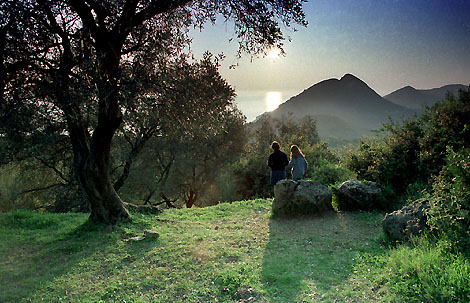
The original Ilfocolor 100 film was taken when that now-defunct film, made as far as I know by Konica, was launched for UK sale by Ilford. It's a view from the top of the centre of Corfu, shot with a now-classic Minolta XD-7 and even more classic 24mm ń2.8 VFC Rokkor MD lens (a Leitz Elmarit-R in Japanese dress with a control added to its floating element to allow variable field curvature). The absence of flare is remarkable, but the density of the sun and reflection in the sea are so far above that of the delicate tones in the olive-tree shadow that extensive burning-in and dodging would be needed to make a print.

The 16-bit Leafscan 45, our regular scanner, eats this huge density range for breakfast. This is an unmodified scan, subjected only to auto Levels balancing and unsharp masking in Photoshop. OK, it's lacking in character.

The Minolta QS35 captured all the detail with surprisingly open shadows and brilliant colour. The raw scan was very blue (see screen shot) and levels balancing cured this. The sky looked almost empty, but a local feathered selection followed by Levels Gamma reduction to 0.30 (extreme) yielded a pure blue distance with clean sun and shine.

The Nikon scan had to be turned down to much darker and inverse gamma correction on the preview to avoid losing the sun detail. The scan needed opening up a lot in Photoshop Levels to reverse this correction, and the sky still needed the 0.30 selective gamma darkening. The effect was however very different and revealed more colour variation (missing in the Minolta raw scan due to the blue cast). In many ways the Nikon result is more graphic, like a ‘Grade 4' colour print with heavy dodging - but would you want this to happen to portrait? Both the new scanners did far better than we expected on this test.